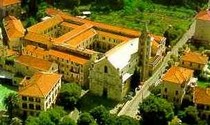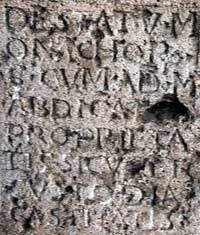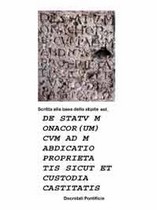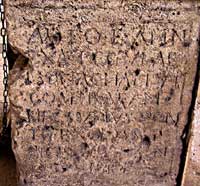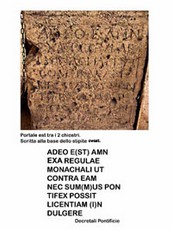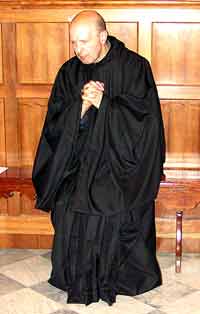portal north
Documents
NORTH SIDE PORTAL
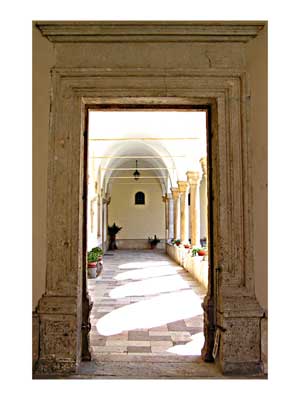 So far we have talked about the A side of the Portal, that side that faces south, the one opening towards that space open for centuries to the population and which - with the passage of time - will become the First cloister.
So far we have talked about the A side of the Portal, that side that faces south, the one opening towards that space open for centuries to the population and which - with the passage of time - will become the First cloister.Free access to this space was dictated by the custom of the people to draw water from a particular well (later eliminated) known for the special goodness of the water vein that was there.
As they say that one cherry leads to another, so it happened that speaking of the A side of the Portal, we too ended up getting carried away to talk about some particularities of our monastery, which entertained us for a few weeks.
The last topic, which we were talking about, concerned access to the Abbey building from the current Piazza Abbazia.
We will resume it in due course, but now we want to conclude with the B side of the Portal, the one that faces north.
This side is exquisitely monastic because it is reserved for the life of the community of monks and since its origins it has been in itself reserved for the monastic cloister.
We no longer find there Saint Jerome, the Madonna of Pia and Saint Benedict.
Much less will we find references to ancient mythology (bull, lion, or even a Fury, complete with snakes as hair), figures often evoked in Renaissance culture (our portal is from 1522, as evidenced by the date that is engraved in the intrados, which -wrongly - is not rarely read 1577.
Fra 'Angelo of Albenga, who had it built, speaks in his autobiography of the inauguration and blessing of this work in 1522. Incidentally, it is recalled that Fra' Angelo di Albenga died in 1534 and that it was very difficult for him to participate in the function of the blessing in the alleged 1577.
Instead of mythology, on the B side of this portal, two solid epigraphic texts appear, in medieval Latin, extracted from the Decretals of Innocent III.
In the history of the Church, the general constitutions issued by the popes were called decretals, which, drawn up in the form of a letter, often contained juridical norms and had mandatory force for all the faithful, except in well-specified cases.
Gathered in three official collections by popes Gregory IX, Boniface VIII and Clement V, the decretals later became part of the canonical Corpus iuris. In fact, Pope Saint Pius X wanted to collect the ecclesiastical legislation in a single text (otherwise known as Codex Iuris Canonici), but the text was published only in 1917 by Benedict XV and was entitled Benedictine Piano Code, from the names of the two popes who created it ( Pius and Benedict) ...
The wear of time has made these two epigraphic texts almost illegible, but with a little good will they can be deciphered and (more importantly) grasped in them the seriousness and the unique splendor of monastic life, which not even a Supreme Pontiff can (funditus) tamper, without running the risk of destroying it.
Today we submit to your kind attention the two epigraphic texts that are found at the base of the two jambs of the Portal. We hope to find, in the coming weeks, time and space to illustrate the treasures that Innocent III, in the wake of the monastic tradition, has scattered (rather than hidden) there.
east portal between the 2 cloisters written at the base of the east jamb:
of the state of the nobles, with the admission of their possessions, as well as the custody of chastity.
decreed pontifically
east portal between the 2 cloisters written at the base of the west jamb:
It is so attached to the monastic rule that not even the supreme pontiff can grant permission against it
decreed pontifically
Step by step we have seen the two apparently tangled epigraphic texts, which are found at the base of the left (east) and right (west) jambs of the north side of the portal, transform into more easily readable Latin texts.
Those accustomed to seeing the clarity and precision of Egyptian hieroglyphic texts carved in the monuments of that country, which in high-definition photographs and videos, are offered to us in publications and on modern screens, may be disappointed by the crudeness of our two epigraphs.
But here we are faced with products from completely different cultures and - above all - the fact that everyone makes a fire with the wood at their disposal.
Finale stone is excellent for many jobs, but not for all.
It is however admirable that, in this case, for 5 centuries it has preserved some traits of our culture.
But what do these Latin texts ever mean to us?
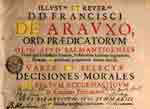 Before continuing to comment on these texts, I feel it my duty to express my heartfelt thanks to Fr. Abate BEDA, who during his Priory in Finalpia was effectively interested in these texts. When I met him at the Sacro Speco in Subiaco in 1999, the then Father Beda (not yet abbot) was Director of the important State Library of the Monastery of Santa Scolastica in Subiaco. It was he, thanks to his professionalism as a competent Library Director, who retrieved a volume from the internet that contained our two texts, which were therefore more easily read (thanks to Don Beda not only the volume we were looking for was found but - and always only online - it was possible to consult the pages that interested us). In fact, the epigraphic style of the writing, the wear and tear of time and the neglect of men made the exact spelling of the writing reported in the Pietra del Finale, with which our Portal is made, problematic in some places.
Before continuing to comment on these texts, I feel it my duty to express my heartfelt thanks to Fr. Abate BEDA, who during his Priory in Finalpia was effectively interested in these texts. When I met him at the Sacro Speco in Subiaco in 1999, the then Father Beda (not yet abbot) was Director of the important State Library of the Monastery of Santa Scolastica in Subiaco. It was he, thanks to his professionalism as a competent Library Director, who retrieved a volume from the internet that contained our two texts, which were therefore more easily read (thanks to Don Beda not only the volume we were looking for was found but - and always only online - it was possible to consult the pages that interested us). In fact, the epigraphic style of the writing, the wear and tear of time and the neglect of men made the exact spelling of the writing reported in the Pietra del Finale, with which our Portal is made, problematic in some places.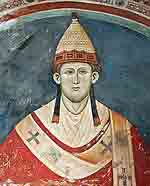 We have finally come to the conclusion of the commentary on the contents of the two epigraphs (tombstones) found at the base of the two jambs on the north side of the Renaissance portal (1522), which leads from the First cloister into the Second one.
We have finally come to the conclusion of the commentary on the contents of the two epigraphs (tombstones) found at the base of the two jambs on the north side of the Renaissance portal (1522), which leads from the First cloister into the Second one.We have verified that the texts are taken from important (decretal) provisions of Innocent III.
We have dissolved the texts written in an epigraphic Latin and worn by time and human neglect, bringing them back to a Latin that is easier to understand and we have revealed the shining treasure they contain.
COMMENTS
1) - RENUNCIATION OF OWNERSHIP AS THE CUSTODY OF CHASTITY
Not a few sages and philosophers of our Greek / Roman civilization renounced the ownership of the goods of this world, because they were considered superfluous.
It is known that Diogenes of Sinope (412 BC circa - 323 BC), called the Cynic (the one famous for having chosen to live in a common barrel), gave up the wooden bowl he used to drink water after noticing a child who drank it with his hands.
In this decretal, Pope Innocent III is not speaking of marital chastity, but of monastic chastity, which involves total sexual continence.
In the Western world this chastity was not considered a value, much less in the official Jewish world, where prolificacy was honored, waiting for the coveted birth of the Messiah.
To see it valued and practiced it would have been necessary to approach the Asian Hindu and Buddhist world.
It is known that Mahatma Gandhi, in agreement with his wife, tried several times to live continent, but in vain. By persisting in this, they achieved the happiness of succeeding.
Thus in the renunciation of property the Pope also included a commitment on the part of the monk to renounce the management of his own body (seen as an intimate personal property).
This renunciation makes the monk's commitment shine with a sparkling prophetic light, as reflected in the words of Jesus regarding the final Resurrection: "When they rise from the dead, in fact, they will neither be husband nor wife, but will be like angels in heaven." (Mk 12, 25).
While then St. Paul will reveal to us that true love (Charitas), that which binds Christians and Christian families in this world, will never end (1 Cor 13:13).
2) - IT IS SO ANNEXED TO THE MONASTIC RULE THAT EVEN THE SUPREME PONTIFF CAN NOT GRANT THE DISPENSE.
Here Innocent III reiterates that, for monks and nuns, the renunciation of property also includes monastic chastity, so much so that not even a Pope can dispense.
Thus it can be concluded that dispensation on one of these two points - even if granted by a Pope - would risk extinguishing the luminous life of about 2000 years of our monasticism.
